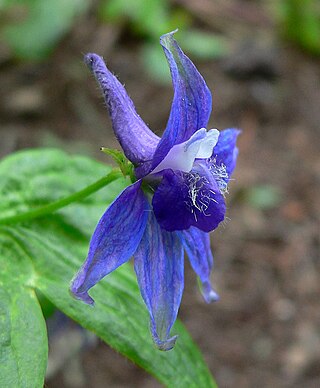
Delphinium bakeri, or Baker's larkspur, is a species of perennial herb in the buttercup family, Ranunculaceae. It is endemic to California in the United States, where it is a federally listed endangered species. It is known in the wild from one remaining occurrence near Salmon Creek in Sonoma County, where only seven plants remained as of March 2006.

Delphinium patens is a species of larkspur known by the common names zigzag larkspur and spreading larkspur. It is a wildflower limited mainly to California. Though not yet confirmed there, it is expected in Baja California. Plants grow typically 20 to 50 centimeters tall and bear up to 36 flowers each. The stems are mostly hairless, have reddish bases, and bears leaves on the lower half. Each leaf is divided into 3 to 9 lobes. The flower has dark blue sepals, the latter ones reflexed. The spur at the back of the flower is 4 to 8 millimeters long. The cleft at the center of the flower has white or yellowish scattered hairs. The elongated fruit is one or two centimeters long and contains pitted seeds.

Delphinium andersonii is a species of perennial larkspur known as Anderson's larkspur. This wildflower is native to western North America, where it can be found in the Great Basin and the Sierra Nevada.

Delphinium cardinale is a species of larkspur known by the common names scarlet larkspur and cardinal larkspur. This wildflower is native to California and Baja California, where it grows on coastal, inland, and desert chaparral slopes, such as the Colorado Desert, and the Peninsular and Transverse Ranges. The presence of diterpenoid alkaloids, probably including the highly toxic methyllycaconitine, in above-ground parts of D. cardinale means that they are likely to be toxic if ingested.
Delphinium decorum is a species of larkspur known by the common names coastal larkspur and yellow-tinge larkspur. This wildflower is native to California and Oregon, where it grows on the slopes of the coastal ranges from the San Francisco Bay Area north to the southern Oregon coast. It has an erect stem which approaches half a meter in height at maximum. The leaves, which are divided into a number of narrow lobes, are mostly located about the base of the plant. The spindly stem above bears two to twenty widely spaced flowers. Each flower is carried on a pedicel several centimeters long. The five long, flat sepals are extended to give the face of the flower a star shape, and they are usually deep blue to purple. The petals are similar in color, except the top two may be lighter to almost white. The spur is very thin and may be nearly two centimeters long.

Delphinium depauperatum is a species of larkspur known by the common names slim larkspur and dwarf larkspur. This wildflower is native to western North America where it is found in mountain meadows. It grows from a short root and erects a stem usually under 40 centimeters in maximum height. The small leaves are divided into lobes and are usually located about the base of the plant. Toward the top of the stem are flowers on long pedicels, with usually not more than 20 flowers per plant. The flowers generally have deep dark blue sepals which are flat and extended to the sides, and petals which are mainly the same color except for the top two, which may be lighter blue to white. The spur is between one and two centimeters long.
Delphinium gracilentum is a species of larkspur known by the common name pine forest larkspur. It is endemic to California, where it grows throughout the Sierra Nevada. This wildflower is usually around half a meter in maximum height, with leaves growing from the lowest third of the stem. The leaves usually have five lobes. The upper part of the stem is occupied by widely spaced flowers, which each grow at the end of a pedicel a few centimeters long. The flower color may be any shade of blue, or occasionally white or pinkish. The sepals often curl backwards. The spur is usually between 1 and 1.5 centimeters long.

Delphinium hansenii is a species of larkspur known by the common names Eldorado larkspur and Hansen's delphinium. It is endemic to California, where it grows in mountains, valleys, and desert from the southern Cascade Range to the Mojave Desert.

Delphinium hesperium is a species of larkspur known by the common name foothill larkspur. It is also sometimes called western larkspur and coastal larkspur, but these names are less specific since other species share them. It is endemic to California, where it grows in woodland and grassland in the northern half of the state. This wildflower generally reaches one-half to one meter in height. It has deeply lobed, prominently veined leaves, mostly located near the base of the plant. The inflorescence may hold very few to over 100 flowers, each on a long, thick pedicel. The flowers are usually a brilliant blue or purple, and sometimes lighter pinkish to white. Often, the sepals are dark in color, and the petals are lighter. The spur is about one to two centimeters long.

Delphinium nuttallianum is a species of larkspur known by the common names two-lobe larkspur, upland larkspur, common larkspur, and Nuttall's larkspur. It is widely distributed across western North America from California to Alberta, including mountain meadows and the majority of the sagebrush steppe, except very dry areas.
Delphinium purpusii is a rare species of larkspur known by the common names Kern County larkspur and rose-flowered larkspur. It is endemic to California where it is known only from Kern and Tulare Counties in the region where the Sierra Nevada meets the Mojave Desert. It grows on rocky cliffs and talus. This wildflower reaches between one half and one meter in height. The erect thin stem has deeply lobed leaves around the base and a small, narrow inflorescence of generally ten to 20 flowers at the top. The flowers of this species are bright pink, making it unusual among the mainly blue-flowered plants of this genus. The sepals curl either forward or back.

Delphinium recurvatum is a species of larkspur known by the common names Byron larkspur, recurved larkspur, and valley larkspur. It is endemic to California, where most of its historical range is in the Central Valley. The grasslands of the valley have been mostly claimed for development and agriculture, so this species is now uncommon. This wildflower reaches a maximum height of about half a meter. Its deeply lobed leaves are mainly basal, with those located further up the dark purple stem being much smaller. The flowers are generally blue, with the sepals and lower petals darker than the upper petals. The sepals are usually curved back, the trait which gives the plant its name.

Delphinium trolliifolium is a species of larkspur known by the common names poison delphinium, cow poison, and Columbian larkspur. It is native to Washington, Oregon, and northern California. This wildflower reaches one half to just over one meter in height. It has large, shiny, deeply lobed leaves. The top half of the stem is an inflorescence of widely spaced flowers on long pedicels, the longest over nine centimeters long. The flowers are usually deep brilliant blue. The upper two petals may be milky white. The spur exceeds two centimeters in length in the largest of the flowers. This plant is toxic as suggested by the common names, but most larkspur species are toxic to some degree.
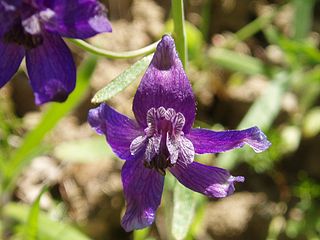
Delphinium variegatum is a species of larkspur known by the common name royal larkspur. It is endemic to California, where it grows in mountains, valley and coast in woodlands and grasslands. On the forest floor of California oak woodlands typical plant associates are Calochortus luteus, Cynoglossum grande and Calochortus amabilis.

Syzygium australe, with many common names that include brush cherry, scrub cherry, creek lilly-pilly, creek satinash, and watergum, is a rainforest tree native to eastern Australia. It can attain a height of up to 35 m with a trunk diameter of 60 cm. In cultivation, this species is usually a small to medium-sized tree with a maximum height of only 18m.
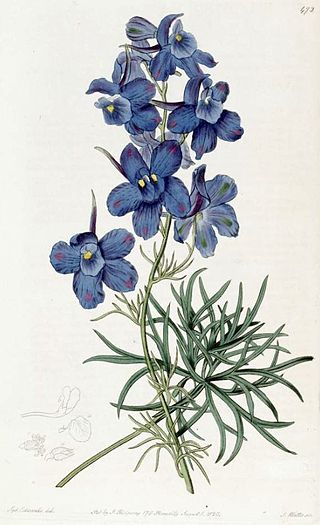
Delphinium grandiflorum is a species of Delphinium known by the common names Siberian larkspur and Chinese Delphinium. It is native to Russia and China. There are several popular cultivars in several colours which are grown as ornamental plants, including 'Blue Butterfly', 'Summer Morning', 'Blue Mirror', and 'Summer Stars'. Like many other larkspurs, this plant is poisonous. It is much shorter and more compact than the more familiar tall D. elatum, with dispersed flowers, rather than single spikes.
Delphinium inopinum is a species of larkspur known by the common name unexpected larkspur. It is endemic to the Sierra Nevada of California, where it is known mostly from rocky areas in open temperate coniferous forest habitat.
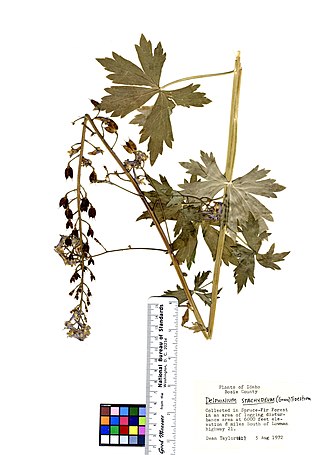
Delphinium stachydeum is a species of larkspur known by the common name spiked larkspur. It is native to the Pacific Northwest and Great Basin of the United States, where it grows in sagebrush scrub and along the edges of mountain forest habitat where it meets prairie and plateau. It is a perennial herb producing at least one erect, slightly hairy stem generally exceeding a meter in height. The multilobed leaves are located mainly on the lower half of the stem except for the area just above ground level. The inflorescence is a branching array of usually more than 30 flowers, each held on a long pedicel. The flower has bright blue sepals around a centimeter long fringed with hairs and surrounding smaller, paler petals. The spur at the back of the flower is just over a centimeter in length.

Delphinium uliginosum is a species of larkspur known by the common names swamp larkspur and bog larkspur. It is endemic to California, where it is known from very localized populations in the Inner North Coast Ranges. It grows in chaparral, grassland, and other habitat in the hills, generally on serpentine soils. This is a perennial herb producing a hairless, erect stem up to 70 centimeters tall. It can be identified by its leaves, which are fan-shaped, a characteristic unique among the larkspurs, which generally have palmate leaves with narrow, fingerlike lobes. The inflorescence bears up to 45 flowers, each on an upright pedicel which may exceed 10 centimeters long. The flower is blue with the longest sepals 1.4 centimeters long and a spur about the same length. The fruit is one or two centimeters long.
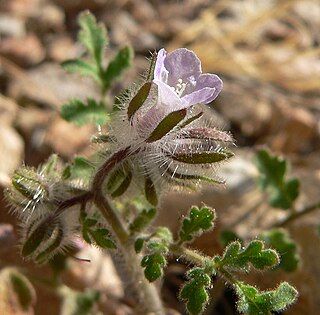
Phacelia cryptantha is a species of flowering plant in the borage family, Boraginaceae, known by the common name hiddenflower phacelia. It is native to the southwestern United States and Baja California in Mexico, where it grows in several habitat types in desert, rocky mountain slopes, canyons, plateau, and other areas.
















